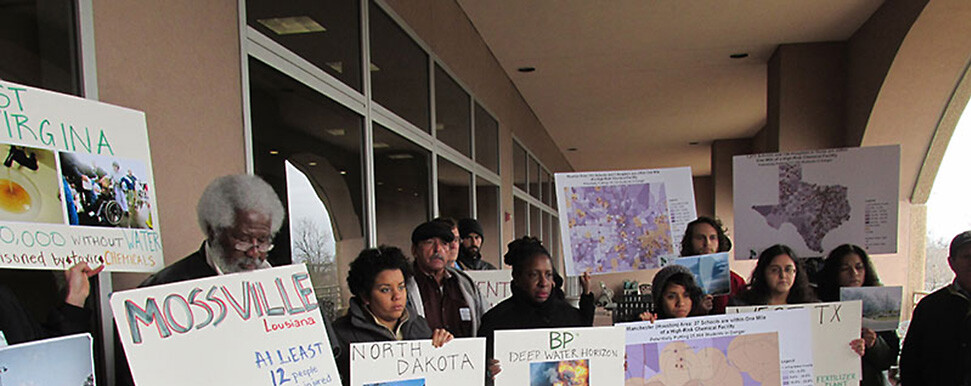
Media
September 29, 2021Chemical Hazards in the Wake of Hurricane Ida, One Month Later
CONTACT: Shayna Samuels, 718-541-4785, shayna@ripplestrategies.com
New Report Profiles Three Toxic Chemical Incidents Caused by Ida and the Need for Stronger Federal Protections to Prevent Further Public Health Risks
A new report released today - exactly one month after Hurricane Ida made landfall and swept through one of the nation’s largest chemical, petroleum and natural gas hubs - documents three of the toxic chemical incidents that occurred as a result of this natural disaster, and how the surrounding communities were impacted. Released by Coming Clean, a national collaborative of environmental health and justice organizations, Unprepared for Disaster: Chemical Hazards in the Wake of Hurricane Ida also calls on the EPA to upgrade their policy - known as the Risk Management Program, or RMP - to prevent chemical disasters like this from happening in the first place.
Across the United States, almost 12,500 high-risk chemical facilities put 39% of the US population who live within three miles of these facilities (and all the employees who work at them) at risk of toxic exposure, injury, or death, disproportionately impacting communities of color and low-income communities.
“This is environmental racism,” said Michele Roberts, National Co-Coordinator of the Environmental Justice Health Alliance for Chemical Policy Reform (EJHA) who also serves on the White House Environmental Justice Advisory Council (WHEJAC) for the Biden Administration. “The health and safety of people in the communities that surround these facilities is not an acceptable risk, especially when practical safer alternatives exist.”
Below are findings from today’s report:
The Shell Chemical, East Site facility in Norco, LA reported releases of hydrogen, hydrogen sulfide, benzene, butadiene, and natural gas (methane). Reports noted that “chemicals are not being burned off properly.” Health hazards of butadiene include cancer and reproductive toxicity. Benzene is known to cause cancer in humans, and is also linked to blood and bone marrow damage, and reproductive health effects in women, among other health and environmental concerns. At any given time, the facility has up to 27.8 million pounds of high-risk chemicals on-site. Over 50,000 people live within 3.1 miles of the facility; 49% are people of color and the per capita income is only $32,587.
The Cornerstone Chemical facility in Waggaman, LA released unknown amounts of sulfur dioxide and sulfur trioxide, and 7,000 pounds of ammonia, into the air. Anhydrous ammonia, which this facility may have more than 50 million pounds of on-site at any given time, is acutely toxic, is a potential endocrine (hormone) disruptor, can cause severe skin burns and eye damage, and poses other health and environmental hazards. Health hazards of sulfur dioxide include developmental toxicity, endocrine (hormone) disruption, acute toxicity if inhaled, and other health and environmental hazards. At any given time, this facility can have more than 88 million pounds of toxic and hazardous chemicals on-site. Almost 30,000 people live within 3.1 miles of this facility, of which 69% are people of color. The per capita income of people living near the facility is $24,476,less than half the per capita income of the metro area.
The CF Industries facility in Donaldsonville, LA reported releases of anhydrous ammonia to the air that employees were “unable to secure.” Anhydrous ammonia is acutely toxic, is a potential endocrine (hormone) disruptor, can cause severe skin burns and eye damage, and poses other health and environmental hazards. At any given time, the facility has up to 328 million pounds of anhydrous ammonia on-site. Over 10,000 people live within 3.1 miles of the facility, with a per capita income of $21,754 (less than half that of the surrounding metro area).
Climate change-related extreme weather events, such as Hurricane Ida, are increasing the vulnerability of chemical facilities such as these nationwide. The Gulf Coast is one of the most vulnerable regions in the country, with more than 2,500 facilities facing elevated risk from natural disasters alone.
Each of these three high-risk facilities, along with 506 others in Louisiana, are only lightly regulated under the RMP - policies that are currently being reviewed by the EPA. Despite the fact that this program was mandated by Congress specifically to prevent chemical incidents, decades of weak rules and lack of preventative requirements have resulted in constant, often avoidable releases and disasters.
“As the communities in Louisiana attempt to recover from Ida, as they do every year from similar natural disasters, the EPA needs to update the RMP to prevent these incidents from occurring in the first place,” said Louisiana native, Wilma Subra, Technical Advisor for the Louisiana Environmental Action Network and former vice-chair of the EPA’s National Advisory Council for Environmental Policy and Technology and the National Environmental Justice Advisory Council. “With President Biden’s commitments to addressing climate change and to environmental justice, it should be a top priority for EPA to produce a strong new RMP rule that will require hazard reductions, address climate change and increase worker participation, among other key measures.”
The report makes the following specific recommendations to the EPA for the updated RMP rule:
- Ensure prevention of chemical disasters by eliminating or reducing hazards.
- Proactively address climate hazards and impacts.
- Strengthen emergency response and incident management requirements.
- Increase enforceability, corrective action, and accountability.
- Expand coverage of the RMP program.
- Address the cumulative hazards and disproportionate impacts in many communities, and ensure environmental justice.
For more details, please see the full report here.
# # #
